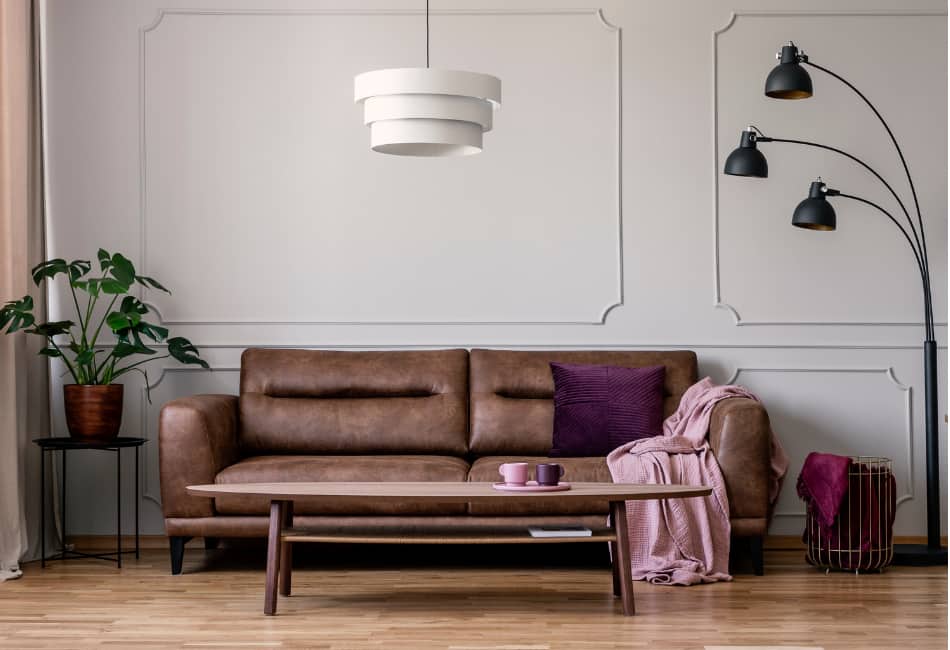Faux leather is a popular choice these days for furniture and upholstery. It’s affordable, looks good, and seems like a safe option. But does faux leather mold? Sit tight as I share with you all of my findings after doing some research and even doing a quick experiment.
What Is Faux Leather Made Of?
To be able to understand if faux leather can mold, we need to understand what it is made of. Faux leather is made of different materials, but the most common material used is PVC.
PVC stands for polyvinyl chloride and it’s a man-made plastic. It can be found in products such as pipes, tubing, wire insulation, credit cards, and fake leather.
Faux leather can also be made of polyurethane (PU). The difference between PVC and PU is that while PVC feels like plastic, PU has a softer feel.
But all in all, faux leather is made of plastics and other synthetic polymers.
As mentioned before, faux leather is made of plastics, and plastics are considered non-porous materials and we all know non-porous surfaces are resistant to mold growth. But does this mean that you can never find molds on plastic and faux leather for that matter?
Does Faux Leather Mold?
Well, faux leather is made of plastic and since plastics are more prone to getting stains from dirt, dust, or grease, these substances could make their way into microscopic holes in the surface of the plastic and in the right conditions encourage mold growth. So Yes! faux leather can get molds too.
While may come as a surprise to some, the fact is that almost any surface can get moldy if the right environment and conditions are present. This means that faux leather while being resistant to most molds, is not immune to it.
Sad to say, but now that we know the answer to the question, let’s get into the details of how faux leather can get mold.
How Does Faux Leather Get Mold?
There are a lot of things that can determine how faux your leather gets mold, how fast the mold occurs, and if it will get mold at all. Some of the things that can affect how likely faux leather is to get mold are:
1. Water Or Dampness
Just like any other surface, faux leather is most likely to get moldy when it’s exposed to water or dampness for a long time.
If you have a couch upholstered in faux leather and you spill water on it, then chances are those liquids will find their way into tiny holes and seams of your furniture. This can create a perfect environment for mold growth.
Also, if you store your faux leather items in a damp place, the moisture from the environment can also encourage mold growth.
2. Humidity And Poor Ventilation
If your faux leather item is in a place that has high levels of humidity and poor air circulation, then it’s very likely to get mold.
Proper temperature control, humidity, and ventilation are key to preventing mold growth on any surface, faux leather included.
This is because excess moisture in the air will settle on surfaces like faux leather and over time, this could also encourage mold growth.
3. Dark And Mold-Infested Areas
Molds are fungi so they grow better in dark areas, so if you have a faux leather item that is exposed to sunlight from time to time, then it’s less likely to get mold.
But if you have an item that’s always in dark or moist areas, then it will be more prone to mold. Sometimes the place you store your faux leather items may already have mold growing there so when you keep your items in that same place, you’re just increasing the chances of it getting mold.
4. Direct Contact With Moldy Surfaces
Similar to the above-mentioned point, if you have a faux leather item and it’s in direct contact with a surface that has mold on it, then there’s a higher chance for your faux leather to get mold too.
This is because when mold spores come in contact with faux leather, it will start to grow and could potentially cause damage to the surface.
5. Food And Beverages
Some food and beverages like tomato sauce, fruit juice, tea, coffee are prone to causing stains on faux leather surfaces. If you spill any of these things on your faux leather item they can also find their way into tiny holes in the surface where mold could begin to grow.
So if you have a dining set that’s upholstered in faux leather, for example, and you end up spilling food or drinks on it without cleaning it, then you’re increasing the chances of mold growth.
6. Temperature
I feel like I did not emphasize this point enough so let me say it again, the temperature of your environment can determine how likely your faux leather is to get mold.
Faux leather is mostly made from plastic and as we know, plastic is a non-porous material so it tends to retain or generate heat quickly. The heat and warmth can then encourage mold growth.
How Does Mold Affect Faux Leather?
Now that we know how faux leather gets mold let’s look at how mold can affect your faux leather items.
Mold Can Affect The Color Of Your Faux Leather Items
If you don’t effectively remove mold on your faux leather items early enough, it can start to change the color of the item.
The mold spreads and in most cases will create a darker stain on your faux leather item. This is not good because if this happens, you may be unable to remove it completely and so you’ll have no choice but to discard the item.
Mold Can Cause Damage To The Surface Of Your Faux Leather Item
If mold is not removed in a timely manner, it will continue to grow and can cause permanent damage to your faux leather surface.
The fungi will start eating away at the plastic material of your furniture and over time could create holes or even completely break the surface.
Mold Can Cause Your Faux Leather Item To Smell Bad
If you do not address mold growth on your faux leather item, it will start to smell bad. The fungus produces a nauseating smell that is difficult to get rid of and so it’s best to take care of it as soon as you notice it.
Mold Can Be Harmful If Inhaled Or Ingested
Mold spores are harmful to both humans and animals if they’re inhaled or ingested. Inhaling mold can cause respiratory problems while ingesting it can lead to digestive problems.
So not only is it unappealing to have mold on your faux leather items, but it’s also potentially dangerous.
Mold Can Spread From One Item To Another
Mold can easily spread from one item to another. So if you have a faux leather bag, for example, and it gets mold on it then that same mold could be transferred to other items such as clothes or other items both in and around the bag.
For this reason, I’d advise that as soon as you see any signs of mold on your faux leather items, you take immediate action to remove them.
How To Remove Mold From Faux Leather
Now that we know all the ways in which mold can affect faux leather, let’s look at how to remove it.
The most important thing is to act quickly because the longer you wait, the more damage the mold will do. You can remove mold from faux leather with a few simple steps:
- First, you need to identify the area that has the mold.
- Next, use a soft brush or cloth to try and remove as much of the spores as possible. You can also use a soft brush or vacuum cleaner.
- If the area is wet, use a dry cloth to absorb as much of the liquid as possible.
- Then, mix one tablespoon of dish soap with one cup of warm water.
- Mix it thoroughly and apply the mixture to a clean sponge.
- Gently scrub away at the area until you see that all the mold is gone.
- Then, wipe down with a wet cloth or paper towel to remove any soap or mold residue.
- Lastly, allow it to air dry by leaving it in an open space where there’s good airflow.
How To Prevent Mold Growth on Faux Leather
Now that you know how to remove mold from faux leather, it’s important to know how to prevent it from growing in the first place.
- The most important thing is to keep your faux leather items dry. This means not exposing them to excessive moisture or humidity.
- You can do this by keeping them in a cool, dry place where there’s good airflow such as a closet or drawer.
- If you’re using them in your home, make sure that they don’t get wet and are not exposed to any kind of liquid spillage.
- You should also avoid placing them near water sources such as sinks, toilets, showers, or bathtubs because these types of environments are conducive to mold growth.
- Regularly clean your faux leather items with a soft brush or vacuum cleaner to remove any spores that may have built up over time.
- The key to preventing mold growth on faux leather is to clean it often with a damp cloth and to allow it to dry completely.
- If you do this on a regular basis, you’ll significantly reduce the chances of mold growth.
- In addition, you can also purchase a product called “Mold Armor” which is specifically designed to remove and prevent mold growth on faux leather.
Final Thoughts
As you can see, the answer to “Does Faux Leather Mold” is yes. Although it’s not as susceptible to mold growth as other materials such as cotton or wool, there are still some things that you need to do in order to prevent it from growing on your faux leather items.
The main thing is keeping them dry and clean. If you do this, you’ll significantly reduce the chances of mold growth on your faux leather items.
I hope this article was helpful in giving you an understanding of how faux leather gets mold, how to remove it, and how to prevent it from reoccurring.

